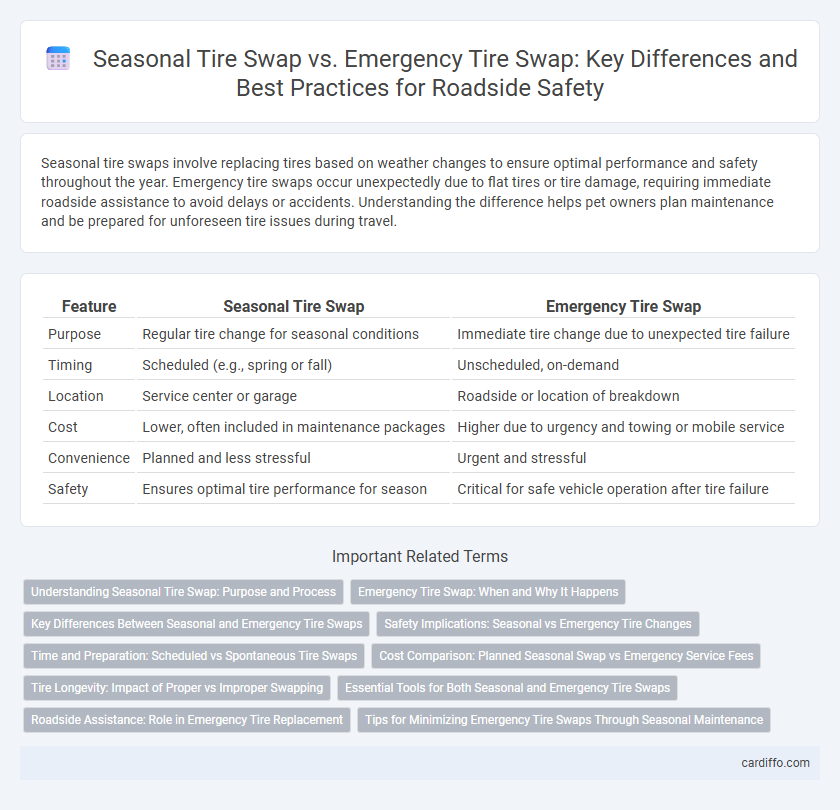Seasonal tire swaps involve replacing tires based on weather changes to ensure optimal performance and safety throughout the year. Emergency tire swaps occur unexpectedly due to flat tires or tire damage, requiring immediate roadside assistance to avoid delays or accidents. Understanding the difference helps pet owners plan maintenance and be prepared for unforeseen tire issues during travel.
Table of Comparison
| Feature | Seasonal Tire Swap | Emergency Tire Swap |
|---|---|---|
| Purpose | Regular tire change for seasonal conditions | Immediate tire change due to unexpected tire failure |
| Timing | Scheduled (e.g., spring or fall) | Unscheduled, on-demand |
| Location | Service center or garage | Roadside or location of breakdown |
| Cost | Lower, often included in maintenance packages | Higher due to urgency and towing or mobile service |
| Convenience | Planned and less stressful | Urgent and stressful |
| Safety | Ensures optimal tire performance for season | Critical for safe vehicle operation after tire failure |
Understanding Seasonal Tire Swap: Purpose and Process
Seasonal tire swap involves replacing winter tires with summer or all-season tires to optimize vehicle performance and safety according to weather conditions, typically scheduled ahead of the cold or warm season. This process ensures proper tread and rubber composition for varying temperatures, improving traction, fuel efficiency, and tire longevity. Unlike emergency tire swaps that address sudden tire failure, seasonal swaps are preventive maintenance performed in controlled settings for optimal tire care and road safety.
Emergency Tire Swap: When and Why It Happens
Emergency tire swaps occur when a tire suddenly fails due to unexpected damage such as punctures, blowouts, or severe tread wear, posing immediate safety risks on the roadside. Unlike a seasonal tire swap, which is planned for optimal performance in changing weather conditions, emergency tire swaps are reactive measures to restore mobility and prevent accidents. Prompt replacement with a functional spare tire is crucial to maintain vehicle control and ensure driver safety during such urgent situations.
Key Differences Between Seasonal and Emergency Tire Swaps
Seasonal tire swaps involve scheduled replacement of summer tires with winter tires or vice versa to enhance vehicle performance and safety under specific weather conditions, typically done before the onset of extreme seasons. Emergency tire swaps occur unexpectedly due to tire damage or failure, requiring immediate replacement to prevent accidents and ensure road safety. Key differences include timing, with seasonal swaps planned and routine, whereas emergency swaps are unplanned and urgent, and the purpose, focusing on weather optimization versus immediate hazard response.
Safety Implications: Seasonal vs Emergency Tire Changes
Seasonal tire swaps, typically performed in controlled environments, ensure optimal tire performance and safety by aligning tire type with weather conditions, reducing risks such as hydroplaning or poor traction. Emergency tire swaps, often conducted roadside under stress and limited resources, increase safety risks due to factors like insufficient lighting, unstable surfaces, and rushed procedures. Prioritizing regular seasonal tire changes and preparing for emergencies with proper equipment can mitigate hazards associated with emergency tire swaps.
Time and Preparation: Scheduled vs Spontaneous Tire Swaps
Seasonal tire swaps are scheduled events planned in advance to optimize vehicle performance and safety for changing weather conditions, typically requiring preparation and time allocation. Emergency tire swaps occur spontaneously due to unexpected tire damage, demanding immediate roadside assistance and quick action to restore drivability. Prioritizing scheduled swaps helps avoid the time pressure and logistical challenges inherent in emergency scenarios.
Cost Comparison: Planned Seasonal Swap vs Emergency Service Fees
Planned seasonal tire swaps typically cost significantly less, averaging $50 to $100, as they are scheduled maintenance performed at tire shops. Emergency tire swaps conducted roadside can range from $150 to $300 due to urgent service fees, travel charges, and limited availability of technicians. Budgeting for seasonal tire changes reduces unexpected expenses and minimizes costly emergency roadside assistance fees.
Tire Longevity: Impact of Proper vs Improper Swapping
Proper seasonal tire swaps extend tire longevity by ensuring optimal tread wear and maintaining balanced performance, reducing the risk of premature tire damage. Emergency tire swaps often result in improper mounting or unbalanced tires, accelerating uneven wear and compromising safety. Consistent, carefully executed seasonal swaps preserve tire integrity, maximizing lifespan and cost-effectiveness.
Essential Tools for Both Seasonal and Emergency Tire Swaps
Essential tools for both seasonal and emergency tire swaps include a reliable jack, a lug wrench, and a spare tire that matches the vehicle's specifications. Seasonal tire swaps often require tire pressure gauges and torque wrenches to ensure optimal performance and safety throughout changing weather conditions. Emergency tire swaps demand compact, easy-to-use tools such as portable impact wrenches and tire inflators to quickly restore mobility on the roadside.
Roadside Assistance: Role in Emergency Tire Replacement
Roadside assistance plays a crucial role in emergency tire replacement by providing immediate support during unexpected tire failures, often ensuring driver safety and minimizing delays. Unlike seasonal tire swaps scheduled ahead of changing weather conditions, emergency tire swaps demand rapid response to prevent accidents or prolonged vehicle immobilization. Equipped with professional tools and expertise, roadside technicians efficiently handle urgent tire replacements to restore vehicle mobility on the spot.
Tips for Minimizing Emergency Tire Swaps Through Seasonal Maintenance
Regular seasonal tire swaps ensure optimal traction and safety by matching tires to weather conditions, greatly reducing the risk of sudden tire failures on the road. Properly storing offseason tires in controlled environments prolongs their lifespan and maintains performance, minimizing emergency replacements caused by premature wear or damage. Routine inspections for tread depth, pressure, and overall tire health during seasonal changes help detect potential issues early, preventing unexpected roadside tire emergencies.
Seasonal Tire Swap vs Emergency Tire Swap Infographic

 cardiffo.com
cardiffo.com